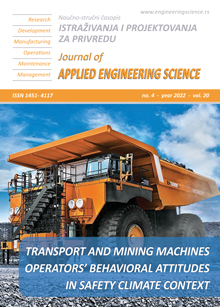DYNAMIC AND PUSHOVER ANALYSIS OF MULTI-STOREY REINFORCED CONCRETE BUILDING USING DIFFERENT LOAD DISTRIBUTION PATTERN
Abstract
One of nature's most dangerous phenomena are earthquakes which cause significant harm to both people's lives and property. In this study, four alternative approaches are used to demonstrate the distribution of lateral loads and compare its impacts on the results of a non-linear static pushover analysis of a ten-storey reinforced concrete (RC) building and study its response to the impact of an earthquake. In order to determine how the structure would respond to earthquake effects, pushover analysis which is an alternative way of time history analysis was adopted and the predicted results are compared with those of nonlinear time history analysis. Given that the building is situated in an area that is actively experiencing earthquakes and has rocky soil, the distributed lateral force is assumed to be equivalent to the design base shear. The study indicated an almost good suitable fit between two categories of pushover loading methods regarding security of the building, maximum base shear, and maximum displacement. The paper also presents a comparison between the results of nonlinear time history analysis at a particular roof displacement with that of pushover analysis.
References
SAP2000 Version 20 (2017). Integrated Software for Structural Analysis & Design, CSI, Computers & Structures, Inc., Structural and Earthquake Engineering Software, Berkeley, California, USA.
FEMA440 (2005). Improvement of Nonlinear Static Seismic Analysis Procedures. Federal Emergency Management Agency, Washington. D.C, USA.
Abd-Elhamed, A., and Mahmoud, S. (2016). Nonlinear Static Analysis of Reinforced Concrete Framed Buildings - A case Study on Cairo earthquake. J.Eng.Res, vol. 4, no. 4, 16-38.
Sarkar, P., Meher, A., and Devdas, M. (2016). Seismic Evaluation of RC Stepped Building Frames Using Improved Pushover Analysis. Earthq. and Struct., vol. 10, no. 4, 913–938, DOI: 10.12989/ eas .2016.10.4.913.
IS 1893 (Part 1) (2002). Criteria for Earthquake Resistant Design of Structures. Indian Standard Part 1 General Provisions and Buildings, (Fifth Revision), Bureau of Indian Standards, New Delhi, India.
Baros, K., and Anagnostopoulos, A. (2017). A New Approach for 3-D Pushover Based Analysis of Asymmetric Buildings: Development and Initial Evaluation. Earthq. And Struct., vol. 2, no. 5, 543–557, DOI: 10. 12989 / eas. 2017.12.5.543.
Samir, B., Jabbar, A., and Mohanned, A. (2018). Pushover Analysis of G+5 Reinforced Concrete Building in Basrah. Int.J.Innov.in Eng. and Tech., vol. 11, no. 1, 53-59, DOI:10.21172/ijiet.111.10.
ATC-40 (1996). Seismic Evaluation and Retrofit of Concrete Buildings. Vol. 1, Applied Technology Council, Redwood City, California 94065, USA.
UBC (1997). Structure design requirement. Vol. 2: International conference of building officials, California, USA. 1997, pp.469.
Zhang, M., Ran, L., Yaoliang, L., and Guifeng, Z. (2018). Seismic Performance of a Corroded Reinforced Concrete Frame Structure Using Pushover Method. Adv. in Civ. Eng ., Vol. 2018, Article ID7208031, 1-12, DOI:10.1155/ 2018 / 7208031.
Mohamed, E., Walid, A., and Wael, M. E. (2019). Seismic Response Modification Factor of Reinforced Concrete Frames Based on Pushover Analysis. J.Arch.Env. and Struct. Eng. Res, vol. 2, no. 2, 30-38, DOI:10.30564/jaeser.v2i2.818.
Pierre, A., Hidayat, I. (2020). Seismic performance of reinforced concrete structures with pushover analysis. IOP Conf. Series: Earth and Environmental Science 426 (2020), 1-10, DOI: 10.1088/1755-1315/426/1/012045
Sullivan, T., Romano, D., O’Reilly, G., Welch, D. & Landi, L. (2021). Simplified Pushover Analysis of Moment Resisting Frame Structures. Journal of Earthquake Engineering. vol. 25, no. 4, 621-648, DOI:10.1080/13632469.2018.1528911.
Rabi, R., Vailati, M., and Monti, G. (2021). Simplified Pushover Analysis for Rapid Assessment of Shear‐Type Frames. Appl. Sci., vol. 11, no. 24,11711, 1-15, DOI:10.3390/app112411711.
Jandal, A. Majied, F. Singh, G., Dubey, H. (2022). Pushover analysis of G+7 residential building with & without shear wall. International Journal of Health Sciences, vol. 6, no. S3, 5539-5557, DOI: 10.53730/ijhs.v6nS3.7172
Themelis, S. (2008). Pushover Analysis for Seismic Assessment and Design of Structures. PhD Dissertation, Heriot-Watt University School of the Built Environment, Edinburgh, Scotland.

